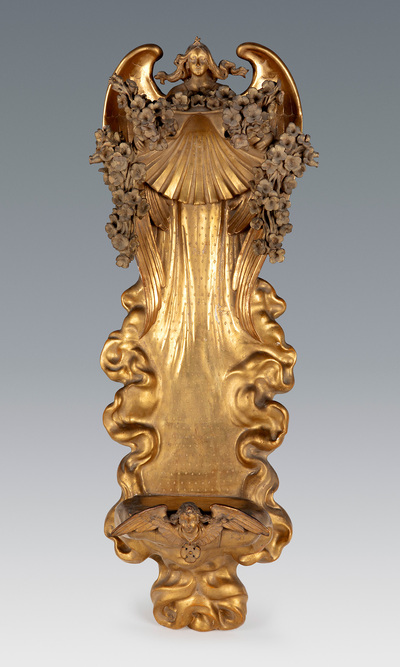Antoni Gaudí: art, religion and nature
The niche in the bidding on the 18th represents a clear example of the mysticism of Gaudí’s legacy.
Antoni Gaudí’s work was a complete revolution in the field of architecture and decorative arts, going down in history as one of the most decisive architects of all time. The greatest exponent of Catalan modernism, his work represents a true icon that, despite remaining forever linked to the image of Barcelona, has achieved a prestige and admiration that knows no borders or cultures. The imprint of his artistic legacy tells us of an era in which the city of Barcelona manifested its freest and most imaginative spirit, betting on the most avant-garde creators, who, like Gaudí, made the dream of building a new Barcelona come true.
Influenced by Wagnerian theories of the total work of art, Gaudí conceived his work under the idea of integrating all the arts into an indivisible higher unity, where architecture, sculpture, design and applied arts will be an extension of each other. Under this precept, each and every one of the elements will be taken care of to the extreme in order to achieve a beauty that could only be found through the perfect coherence and conjunction of unity in the whole.
In this sense, the importance that Gaudí will give to the different architectural and decorative elements is evident in the design of the niche we are dealing with, whose remarkable workmanship is evident in every detail that ornaments the gilded carving. It combines various aspects of Gaudí’s aesthetic and iconographic ideology, intimately related to his spiritual fervor and love for the natural world. The lower part, starring a cherub with open wings, starts with a structure decorated with intertwined scroll motifs. Around the small niche that follows it, a continuum of curved and undulating forms develops without interruption, culminating in the figure of a winged nymph, wrapped in exuberant floral bouquets, emerging on a venereal shell.
The profuse interest in the ornamental latent in this piece will be the common denominator of the modernist arts, whose spaces and surfaces will be saturated with all kinds of stimuli characterized by a great visual sensualism. His aesthetics dominated by the dynamism of the undulating and sinuous forms of nature will break with the structural rigidity of Gothic, from which Gaudí, despite sharing the idea of verticality as a connection between the earthly and celestial worlds, moved away to defend the curve as the line of God, as opposed to the straight line of the human being.
The evident symbolic charge is manifested in this piece under a typically Gaudí iconography in which we can already detect the axes that were the backbone of his thought and particular vision of the world. On the one hand, his deep commitment to the Catholic faith transcends through elements such as the venera shell, whose presence reminds us that our life must be a constant pilgrimage in the footsteps of Jesus. The Christian dogma is reinforced by the figure of the cherub who, as God’s messenger, brings us closer to the faith of the creator, reminding humanity of his divine glory.
The religious content is complemented by a repertoire of forms and elements taken from Nature, which, as the primordial source of his art, will become, as he himself stated, his best teacher. Understood as the summit of the divine work, Gaudí found in it the principles that governed his work, reaching a mystical expressiveness that could only be accessed through the application of the organic laws of nature. In this way, the various plant and floral elements, in conjunction with the organic forms that unfold, They manage to connect and identify artistic practice as part of natural creation and, therefore, a reflection of the divine. The references to the natural world culminate with the nymph that crowns the structure, whose condition as a magical being that is born and guards the forests, represents in itself an allegory of nature.
Gaudí’s talent and his impact gave birth to an era of splendor for the arts: technique, aesthetics and religion were masterfully united, always evoking Mother Nature as the symbol par excellence of divine creation. We are fortunate that it was in Barcelona where the infinite imagination of this genius crystallized.






